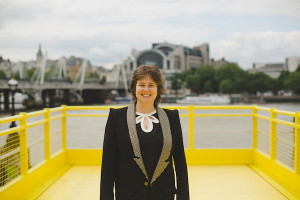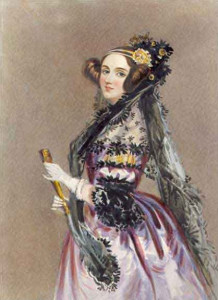 Anyone who caught any of this summer’s BBC Proms may have noticed that in the midst of the World’s Greatest Classical Music Festival, someone managed to sneak in a bit of mathematics. Emily Howard, whose degree was in Mathematics and Computing at Oxford, has become a composer whose works are performed alongside Glinka and Shostakovich. I spoke to Emily about her latest composition, Calculus of the Nervous System, which was part of this year’s Prom 51, on 21st August.
Anyone who caught any of this summer’s BBC Proms may have noticed that in the midst of the World’s Greatest Classical Music Festival, someone managed to sneak in a bit of mathematics. Emily Howard, whose degree was in Mathematics and Computing at Oxford, has become a composer whose works are performed alongside Glinka and Shostakovich. I spoke to Emily about her latest composition, Calculus of the Nervous System, which was part of this year’s Prom 51, on 21st August.
Emily has been composing since she was a child, and in fact had her first orchestral piece played by the Liverpool Mozart Orchestra at the age of 7 – but she also loved science, and so chose to study maths and computing. On completing her degree, she felt that the natural thing to do was move into composition, and she now holds a doctorate in composition from the University of Manchester. “Although I enjoyed my undergraduate degree immensely, studying maths and computing made me realise that I missed music a lot – that’s when I knew I should become a composer. Creatively, working with sound suits me far better.”
While Emily had no formal composition training until postgraduate level, she did have formal training in mathematics, and she feels that this has informed her composition style. “It was natural to use techniques from maths in my composition.” Her work incorporates mathematical functions such as exponentials, random numbers and layered combinations of these. As well as helping her to decide the overall structure of the piece, such as where the dramatic moments will be, it can also specify aspects of the music on a micro level, such as rhythm, pitch and which section of the orchestra is playing. “Composition is all about making decisions.” Emily’s choice to use mathematical techniques often helps to make those decisions for her – to the point that she sometimes uses computer programs which speed up areas of the compositional process.

“Calculus of the Nervous System” was a phrase used by Ada Lovelace to describe her attempt to create a mathematical model for how nerve impulses give rise to thoughts and feelings in the brain. Ada, the daughter of Lord Byron, worked with Charles Babbage on his difference engine and was instrumental in documenting the construction of the engine. Howard’s composition, inspired by Lovelace, brings together many of her mathematical function composition techniques, as well as incorporating aspects of neural networks, and is constructed as a sequence of memories, some more clear than others, which overlap and interact: “like a muddled brain”.
This isn’t the first piece inspired by Lovelace that Emily has written; her ‘Ada Sketches’, written for mezzo-soprano, flute, clarinet and percussion, is a short dramatic vocal work in which Ada ‐ immersed in calculations – imagines that the analytical engine might compose music. ”Ada said, ‘Suppose these numbers represented musical notes; we could feed them into the engine and see what comes out’. This was very prescient of her – she was years ahead of electronic music and computer generated music.” Emily hopes that ‘Ada Sketches’ , which incorporates Ada’s voice as she works with the engine, and aspects of her character, as well as the engine itself being present and ‘speaking’ in the music, might form the basis of a future opera.
Emily is also mentoring a pilot project with students from the Bridge Academy, a school in Hackney, London which has specialisms in both mathematics and music. “The year 9s have been working with members of the London Symphony Orchestra to develop a composition based on mathematical principles facilitated by myself and Michael Betteridge, a postgraduate composer studying at the Royal Northern College of Music. The mathematics involved in their composition is the mathematics they’re learning at school.” The composition resulting from this week-long creative project was performed at a school concert by members of the London Symphony Orchestra alongside the students who composed the work. This sounds like a fantastic way to get the kids interested in both maths and music, and I hope that as many are inspired by it to go on and become mathematicians as composers.
Emily’s website lists all of her compositions, many of which are inspired by mathematical and scientific concepts, as well as information about future performances of her works. Do you have both a musical and a mathematical side? What’s your favourite mathematically-inspired piece of music? Comments below.
Very misleading article. I clicked expecting to see the actual explanation of calculus in our nervous systems. Instead, you just provided a biographical praise of Ada Lovelace.
Very misleading article. I clicked expecting to see the actual explanation of calculus in our nervous systems. Instead, you provided a biographical praise of Ada Lovelace.